|
EQUINE CLICKER TRAINING..... using precision and positive reinforcement to teach horses and people |
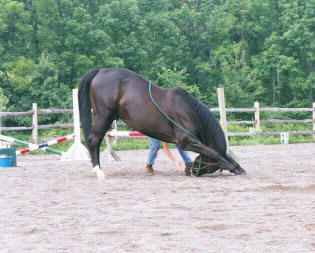
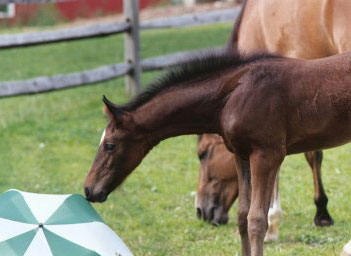
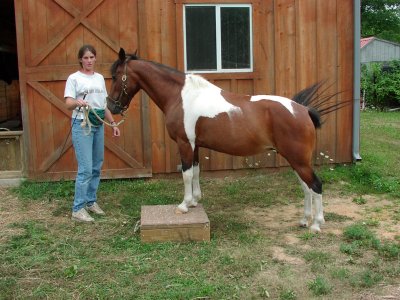
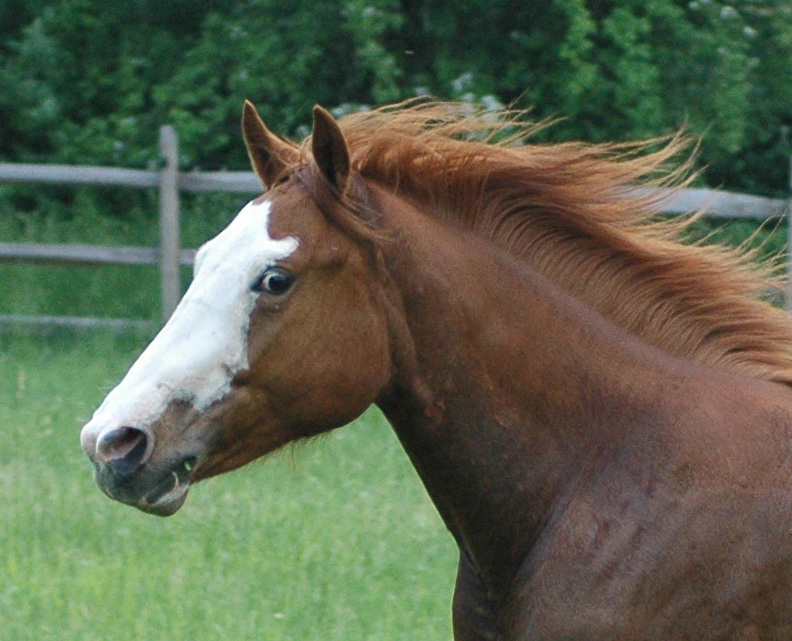
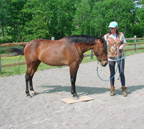
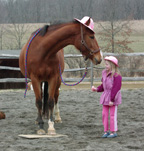
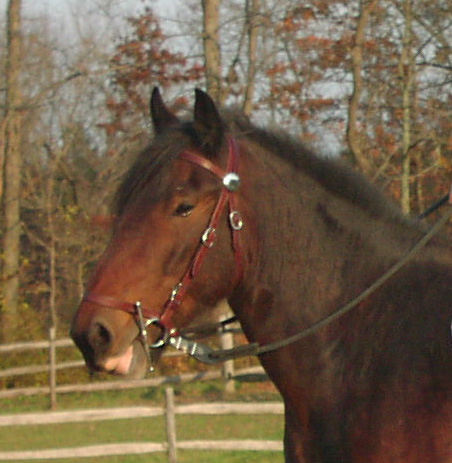
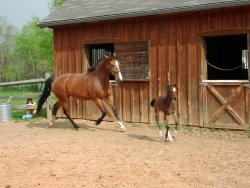 |
|
Alexandra Kurland Advanced Clinic: Groton, NY, May 2011
These were originally posted as notes on facebook. The dates are when I posted them.
May 18, 2011 At this clinic we had three horses that were new to the arena and one was on her first trip away from home. Alex used simple exercises with the cones and mat to help each horse settle down and become more confident about working in a new space. It was interesting to watch because it just worked out that each horse was a variation on the same theme. One horse had been reinforced a lot for touching objects and was very keen on touching the cones that marked the cone circle. Alex had the owner allow him to touch the cones and walk from cone to cone on day 1. By day 3, she had added a lot of other behaviors in between the cone touches and the horse had to show some emotional control and wait to be released to touch the cone. With another horse, Alex used the mat in the middle of the cone circle as the place of high reinforcement and had the owner walk her out around a cone (looking for good turns) and then return to the mat. Over the three days, most of her reinforcement shifted from standing on the mat to marking good balance shifts as she walked around the cones. On the third day, Alex added left and right touches on the mat (touching the owners left or right hands as targets) to make the mat work more interesting. The third horse was an older mare who didn't seem nervous about being in the arena but she was newer to clicker training than the others, so Alex had her work on a simple behavior. Her owner had done some mat work but wasn't sure the mare quite understood the click was for standing on the mat. They started by using the mat and working on quiet feet and duration on the mat. This led to using the mat and grown-ups to teach ground tying. Even though the mare was not moving around because she was nervous (I don't think), she did need to learn to stand still between the click and the treat. This brought up some interesting points about food delivery which I will cover another day. May 19, 2011 In yesterday's note, I mentioned that there was one horse that showed us an interesting point about food delivery. This mare was being shaped to stand on the mat but she had a lot of foot movement, both before and after the click so she would be stepping on and off the mat instead of standing solidly on it. It is not unusual to see this in the early stages of mat work, but after a few minutes, it became clear there was something else going on. It turned out that the mare had been taught to step back for food delivery so every time the owner clicked, she stepped back off the mat as the food was presented. It took most of the clinic to teach her that she could remain in position after the click. This led to Alex having us take a closer look at food delivery. Alex had us practice (in pairs, one person was the horse, the other was the trainer) food delivery with the emphasis on varying some elements of it. She wanted us to be able to feed the horse from various positions around the head so that the horse understood that if the trainer moved during food delivery, it did not mean the horse had to move. A key point here is that we did not change the location in which the food was presented. We always fed "where the perfect horse would be" which is with the head forward, so this was not about feeding in different locations. This was about teaching the horse that our movement during food delivery did not necessarily mean the horse had to move. This exercise is useful for a horse that has gotten overly sensitive about the trainer moving between the click and treat and also can be a step toward teaching ground tying. This is not only a specific example of how food delivery interfered with shaping a behavior, which is interesting in itself, but it also points out how important it is to teach your horse that he/ she needs to look to the trainer for information about food delivery. It also suggests that it is important to vary your food delivery so that you have options for how you feed. With my horses, most of the time I feed in position. But I do sometimes ask them to back or come forward. And I also teach them that I can feed them while we are moving so that in certain cases, the click does not mean stop. I don't mix these things up randomly during sessions as that would be unnecessarily confusing to a horse. Instead I choose the method of food delivery that is most effective for each exercise and I am consistent about using that method for that exercise. Since my horses are used to several different methods of food delivery, they are quick to catch on to which one I am using at any given time.
May 20, 2011 Loopy training is clearly on Alex's mind. If you don't know what Loopy Training is, you can read about it on my website in the articles section or read about/buy her new DVD on her website. Over the course of the weekend, Alex showed us how to use loopy training for more advanced behaviors. In the past I have seen her set up loops using the foundation behaviors and she did some of that at this clinic with combinations of mat work, targeting and turns around cones. But what I want to talk about here is using it for riding or more advanced work. In riding (or groundwork), the initial stages of loopy training start with choosing a base (or anchor) behavior. You can choose a behavior like halt or go to the mat, but you can also choose a behavior that is more related to developing balance in the horse. In the title I used the phrase "reinforcing a reaction pattern," and this is what Alex called it when you ask the horse to make a balance adjustment or to respond to cues by moving its body in a specific way. So you are reinforcing a response until it becomes automatic. The example I am going to use is a horse that tended to lean on his inside shoulder. Alex had the rider ask the horse to rebalance (could be anything from a weight shift to actually moving up and over) by lifting her inside hand up using the rein mechanics from the hot walker lesson. Initially the rider was reinforcing fairly infrequently and looking for the horse to either keep his balance or move over a lot, but this was not getting very clean results. So Alex had her tighten up the loop by walking off on a loose rein, asking the horse to rebalance, clicking and treating and then repeating it. She didn't want to ask for more until the horse was clearly responding to the rider's request. This is what she called "reinforcing the reaction pattern" and she wanted them to practice that little piece until it became so automatic that the horse responded to the rider promptly every time. This could sound like putting a behavior on a high rate of reinforcement until the horse knows the cue and in some ways, that is what Alex was doing. But I think there is a difference because when a horse is in motion, his balance is constantly changing and so every repetition could be slightly different. The horse has to do a lot of repetitions and experience a lot of variations in how he rebalances before he can respond fluently. The point Alex was making was that you need to keep the loop small and clean so that the horse can really focus on figuring out how to move his body to respond to the cue. This relates back to the idea of "reinforce for response" which I mentioned a while back. The rider needs to start by reinforcing for responding to the cue (and not go for more) which means there will be a period where you don't look for more duration or more repetitions, but just keep fine tuning the horse's reaction to your aids. Initially the rider needs to reinforce the initial response and weight shift instead of going for more steps sideways. This can seem like it is taking more time to build the behavior, but taking the time to reinforce the response to the cue pays off in that you keep the behavior connected to the cue and both you and the horse get lots of practice in the initial rebalancing which is really the hard part. In this particular example, the horse leaned on his shoulder and the rider had gotten in the habit of taking the inside rein across the neck to drag him out. So in addition to focusing on changing how the horse moved, Alex was working on "rewiring" how the rider moved when she wanted him to rebalance and the reaction pattern for the rider was when the horse leans, take your hand up, not over. I used a riding example, but I think there are lots of times when it is important to go back and look at how clearly the horse is responding to a cue and also at how clear we are about the cue. Whether you think of it as reinforcing a reaction pattern, making a small loop, or refining stimulus control, it is always helpful to pull out one piece and put some time into really cleaning it up. May 23, 2011 One of the topics that came up at the clinic was directed vs. self-directed learning. Alex uses the terms to indicate the degree of guidance that is present when you learn something new. In directed learning, you have a teacher who is giving instructions or you are following a pre-determined training plan. In self-directed learning, you are working more on your own and making your own choices about what to try. The terms could be used to apply to either the horse or the handler. And you can have different combinations and degrees of each. This is similar to something I wrote about previously. In the ClickerExpo report for Kay Laurence, I described how she views training as a continuum where free-shaping is on one end and more controlled learning (luring, molding, etc...) are on the other end. This is another way of describing the range of ways we can train and how you can create trainers and/or learners who are good at being directed and/or confident working on their own. I think it's useful to be aware that this continuum exists because the training methods we choose affect the kind of learner we create. Do we want an animal that thinks on its own or one that expects a certain amount of guidance from the trainer? Maybe we want the animal to behave differently in different situations. My horses are used to free-shaping but they also work well under directed guidance. Another reason to be aware of where I am working on this continuum is that I find that how I train (rate of reinforcement, how quickly I change criteria, length of session, etc...) is different for directed vs. self-directed learning. For example, in free-shaping (self-directed learning), if I reinforce too much at a certain stage, it's easy for the behavior to get stuck at that point, so I tend to keep looking for the next change in criteria. But when I am using pressure and release (directed learning) I know that I can change lots of things about how I ask (body language etc..) to get different variations so I don't worry so much about stalling out if I choose to reinforce the same response a lot of times. This goes back to the previous note on reinforcing reaction patterns. When I am teaching a horse to move his body in a new way, I know that it takes time for the horse to be able to reliably find that new balance and it is important to stay at that first step until the horse is really fluent in it. Alex didn't talk about this at the clinic, but writing about self-directed vs. directed learning has gotten me thinking a bit more about how there is a natural progression from directed to self-directed learning as we learn more about a subject. She did say that her goal is to create self-directed trainers. She wants to teach us enough tools to fill our toolboxes so that we can go out and solve our own training problems. I would like to think that while we are busy filling our own toolboxes, our horses are too, as they learn to develop their problem solving skills and build their own body awareness.
|